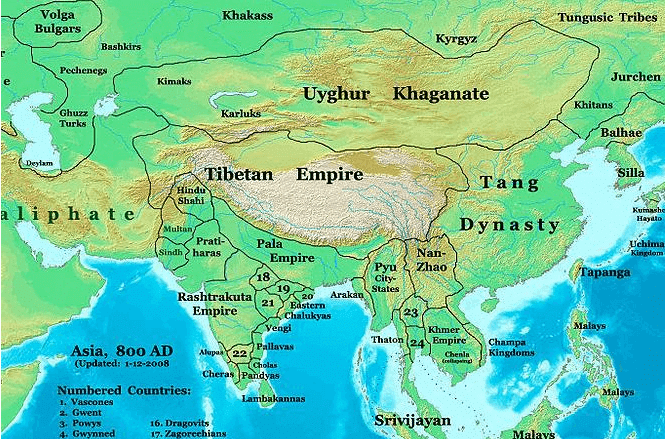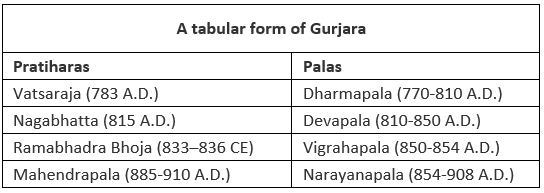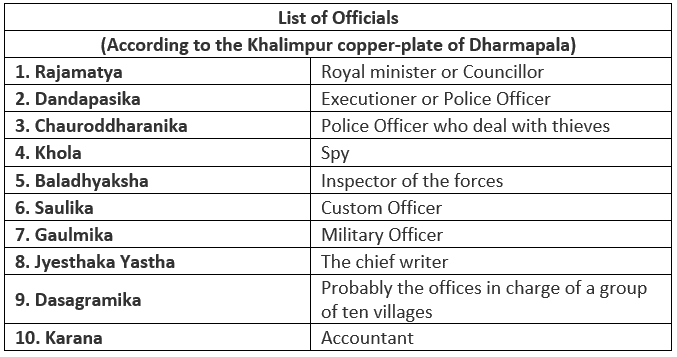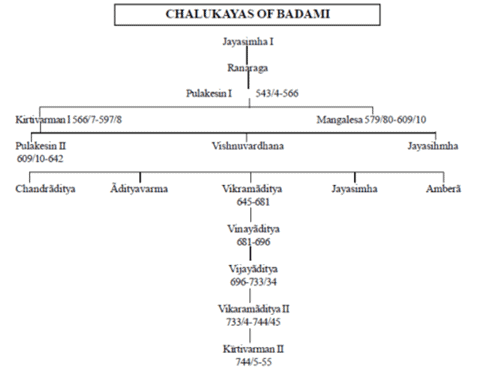UPSC Exam > UPSC Notes > History for UPSC CSE > The Pala Empire & Senas of Bengal
The Pala Empire & Senas of Bengal | History for UPSC CSE PDF Download
Political Condition
- After the death of Yasovarman, there commenced a tripartite struggle for supremacy between three great powers; the Gurjara Pratiharas, the Palas, and the Rashtrakutas, and the ambition was always the occupation of the imperial city of Kanauj.
 Pala Empire
Pala Empire
- Gopala, the founder of the Pala dynasty, reigned in the third quarter of the 8th century A.D. and was succeeded by his son Dharmapala.
- The kingdom of the Palas now comprised Gauda, Vanga, Radha, and Magadha.
- Dharmapala, which was the most powerful king of the dynasty, tried to establish an empire in north India. This involved him in war with the Pratiharas of Malwa and the Rashtrakutas of Deccan, who tried to expand their kingdom.
- Devapala, which succeeded his father Dharmapala, intended to establish an empire and led expeditions against many states. He defeated the king of Gurjara and reached Kamboja country. He conquered Pragjyotisha (Assam) and Utkala and curbed the pride of the king of Dravida.

- Devapala was succeeded by Vigrahapala. He was a weak king and abdicated the throne after a short reign of three or four years.
- His son and successor, Narayanapala ruled for more than half a century. But he was a man of a pacific and religious disposition.

- After the death of Naryanapala, his son Rajyapala ascended the throne. He was also a weak ruler. His two successors Gopala II and Vigrahapala were equally weak and the result was that the Pala Kingdom became confined ta part of Bengal.
- After the death of Vigraha Pala, Mahipala I became the king. He was a brave soldier and was soon able to restore the lost position of the Pala dynasty.
- He is, therefore, called the second founder of the Pala Kingdom.
- It was during his reign that Rajendra Chola of Kanchi attacked Bengal but the Southern adventurer had ultimately treated back.
- After the death of Mahipala, there was a succession of rulers, Nayapala, Vigrahapala III, Mahipala II, Surpala II, Rampala and Madhavapala were not as strong as Devapala and Mahipala.
- The rule of the Pala dynasty came to end about the middle of the 12th century A.D.
Question for The Pala Empire & Senas of BengalTry yourself: Who was the founder of the Pala dynasty?View Solution
The Senas of Bengal

Pratiharas
- A branch of the Pratiharas, founded by the son of the Brahmana Harichandra by his Kshatriya wife, ruled in the Jodhpur State, Rajasthan, which was situated in Gujarati, also known as Gurjara.
- Another branch of the family, the members of which seem to have been descendants of Harichandra by his Brahmana wife, founded a kingdom in Malwa, the capital of which was Ujjain, in the first half of the 8th century.
- The earliest known king of this branch was Nagabhatta I, where fame by repulsing an attack of the Arabs of Sindh.
- The next important king, his grand-nephew Nataraja, is known to have been ruling in 783 A.D. He extended his kingdom up to Jodhpur, which proves that Gujarati was included in his kingdom.
- He defeated Dharmapala, the Pala ruler of Bengal, but himself suffered a reverse at the hands of the Rashtrakuta Dhruva III.
- His son and successor, Nagabhatta II, was defeated and deprived of his throne of Malwa by the Rashtrakuta Govinda III, and he thereafter established himself in Gujarati. Later he took Kanauj from Chakrayudha and shifted his capital there.
- The greatest king of this dynasty was Bhoja who had succeeded his father Ramabhadra in or about 836 A.D. He had some initial success and was a master of both Kanauj and Kalanjara.
- He was, however, defeated by Devapala and fared better against the Rashtrakutas. He secured the aid of the powerful Chedi rulers of Gorakhpur and probably also of the Gahilot king. Assisted by these powerful chiefs, Bhoja had probably great difficulty in inflicting a crushing defeat upon the warlike king that sat upon the throne of Dharmapala and Devapala.
- He defeated Krishna II, probably on the bank of Narmada, and occupied Malwa. He then advanced towards Gujarat and occupied the territory around Khetaka. But although this was recovered by Krishna II, Bhoja maintained his supremacy over the whole of the Kathiawar Peninsula.
- A sanguinary battle was fought between Bhoja and Krishna II at Ujjayini which was long remembered by posterity. But it led to a decisive result, and Malwa remained in the hands of the Pratiharas.

- Bhoja died about 885 A.D., leaving a consolidated empire this son and successor Mahendrapala.
- Under Mahendrapala, Magadha and at least a considerable portion of North Bengal was added to the Pratihara empire.
Question for The Pala Empire & Senas of BengalTry yourself: What were the major powers involved in the tripartite struggle for supremacy after the death of Yasovarman?View Solution
- Mahendrapala was succeeded by his two sons, Bhoja II and Mahipala. Although Mahipala may be credited with retrieving his fortunes to a large extent, there can be a question that the prestige of the Pratiharas sustained a serious blow.
- The history of the Pratihara kings after Mahipala is somewhat obscure. But it seems that he was succeeded by his three sons, Mahendrapala II (945 A.D.), Devapala (948 A.D.), and Vijayapala (960 A.D.).
The document The Pala Empire & Senas of Bengal | History for UPSC CSE is a part of the UPSC Course History for UPSC CSE.
All you need of UPSC at this link: UPSC
|
210 videos|855 docs|219 tests
|
FAQs on The Pala Empire & Senas of Bengal - History for UPSC CSE
| 1. What was the political condition during the Pala Empire and Senas of Bengal? |  |
Ans. During the Pala Empire and Senas of Bengal, the political condition was characterized by the emergence of powerful dynasties that ruled over large territories. These dynasties were able to establish their authority through a combination of military conquests, political alliances, and cultural patronage. The Pala Empire was known for its administrative efficiency and patronage of Buddhist learning, while the Senas of Bengal were known for their military prowess.
| 2. Who were the Senas of Bengal? |  |
Ans. The Senas of Bengal were a powerful dynasty that ruled over Bengal from the 11th to the 12th centuries CE. They were known for their military prowess and were able to expand their territory through a combination of conquest and political alliances. The Senas patronized Hinduism and were responsible for the construction of many temples and other religious structures in Bengal.
| 3. What was the significance of the Pratiharas during this period? |  |
Ans. The Pratiharas were a powerful dynasty that ruled over much of North India during the 8th to 11th centuries CE. They were known for their military prowess and were able to establish their authority over a vast territory through a combination of conquest and political alliances. The Pratiharas were also known for their patronage of the arts, particularly literature and sculpture.
| 4. What was the role of cultural patronage during this period? |  |
Ans. Cultural patronage played an important role during the Pala Empire and Senas of Bengal. Both dynasties patronized the arts, particularly literature, sculpture, and architecture. The Pala Empire was known for its patronage of Buddhist learning and the construction of many Buddhist temples and monasteries. The Senas of Bengal, on the other hand, patronized Hinduism and were responsible for the construction of many temples and other religious structures in Bengal.
| 5. What was the legacy of the Pala Empire and Senas of Bengal? |  |
Ans. The legacy of the Pala Empire and Senas of Bengal can be seen in the cultural and architectural heritage of the region. Both dynasties were responsible for the construction of many temples and other religious structures, many of which still stand today. The Pala Empire is also known for its patronage of Buddhist learning, which had a lasting impact on the culture and intellectual life of the region. The Senas of Bengal, on the other hand, are known for their military prowess and their role in the establishment of Hinduism as the dominant religion in the region.
Related Searches

















